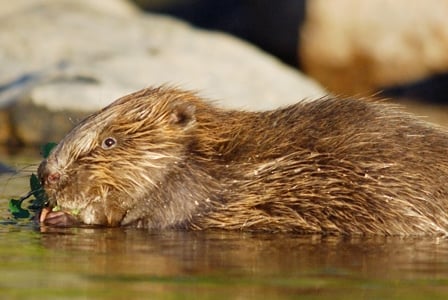
Did you know that our dam-building neighbours have German (and French, Italian, and Russian) speaking cousins? On this Wildlife Wednesday, lets learn about the Eurasian beaver.
They may be the butt end of many jokes, what with their flat, funny-looking tail and all, but it’s no joke that we Canadians have a soft spot for the furry animal adorning our five cent piece. Did you know, though, that our dam-building neighbours have German (and French, Italian, and Russian) speaking cousins?
On this Wildlife Wednesday, let’s unearth some information about a plucky creature who paddled its way back from the edge of extinction, the Eurasian beaver.
Habitat
These buck-toothed branch eaters make their lodges in the many lakes, swamps, streams, and other bodies of water that dot the European landscape. They can be spotted swimming in France, Italy, and even European Russia and Mongolia.
Trivia
- These beavers have the distinction of being Europe’s largest rodent. Worldwide, they’re second to only the capybara—they’re even bigger than their American relatives!
- They also win the silver medal for being the second-most able to manipulate their environment to suit their needs. The first place winner? Humans.
- Beavers might be clumsy on land, but they’re well suited to life in the water. Beyond their webbed feet and their famously flat tail, their ear openings and nostrils can close when they slip under the water, and their eyes have nictitating membranes that act like water goggles.
- While they sport a thick, brown coat like their North American cousins, the pelts of Eurasian beavers change depending on where they live, ranging from a light chestnut to nearly black.
Why are they threatened?
In Europe, fortunately, they’re not threatened … anymore, at least.
Historically, these dam makers went through a dramatic population decline due to overhunting for their fur, meat, and castoreum (a sweet-smelling chemical used by perfume markers). Then, in the 19th century, many European marshlands were drained, resulting in significant habitat loss and compounding the problem. By the beginning of the 20th century, there were no more than about 1,200 beavers left.
When European governments noticed the beavers’ dwindling numbers, however, conservation measures were put into effect—starting with a hunting ban by Norway in 1845, and following with other hunting restrictions, reintroductions, and habitat protection. Thanks to these efforts, recent estimates suggest that as many as 639,000 of the tail slappers get to say “guten morgen” (or “bon nuit” or “buonanotte”) each night.















